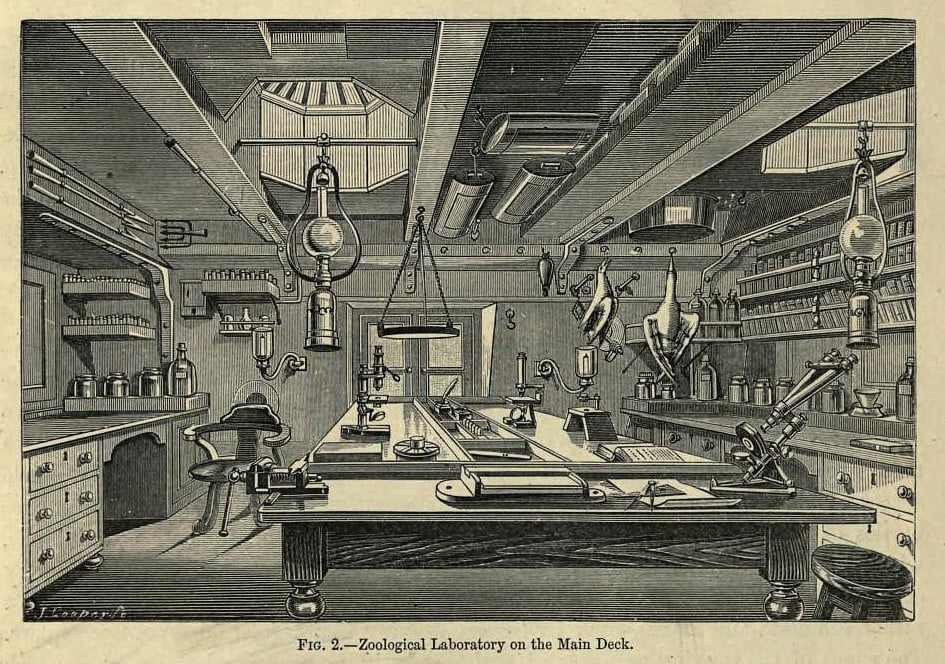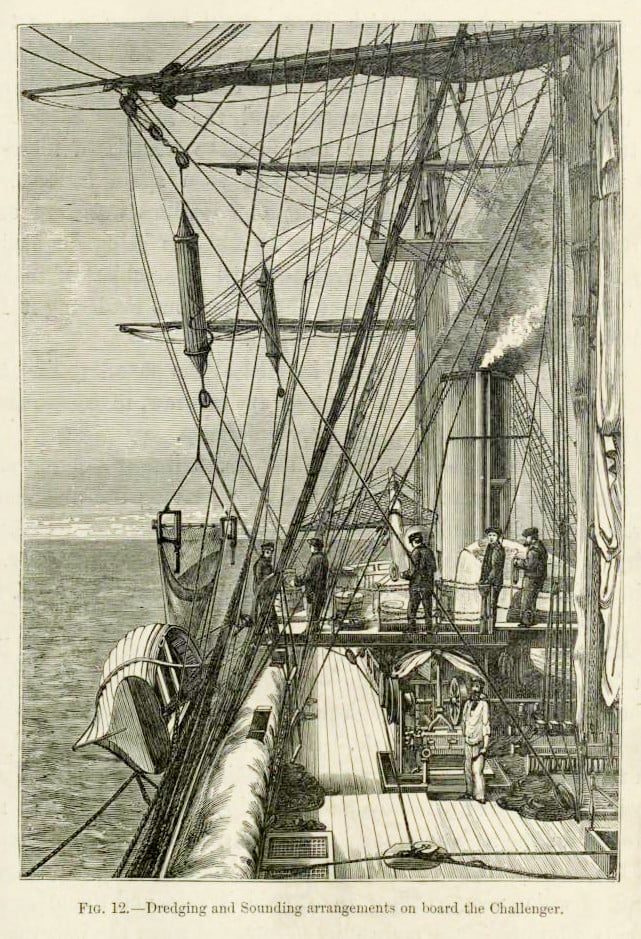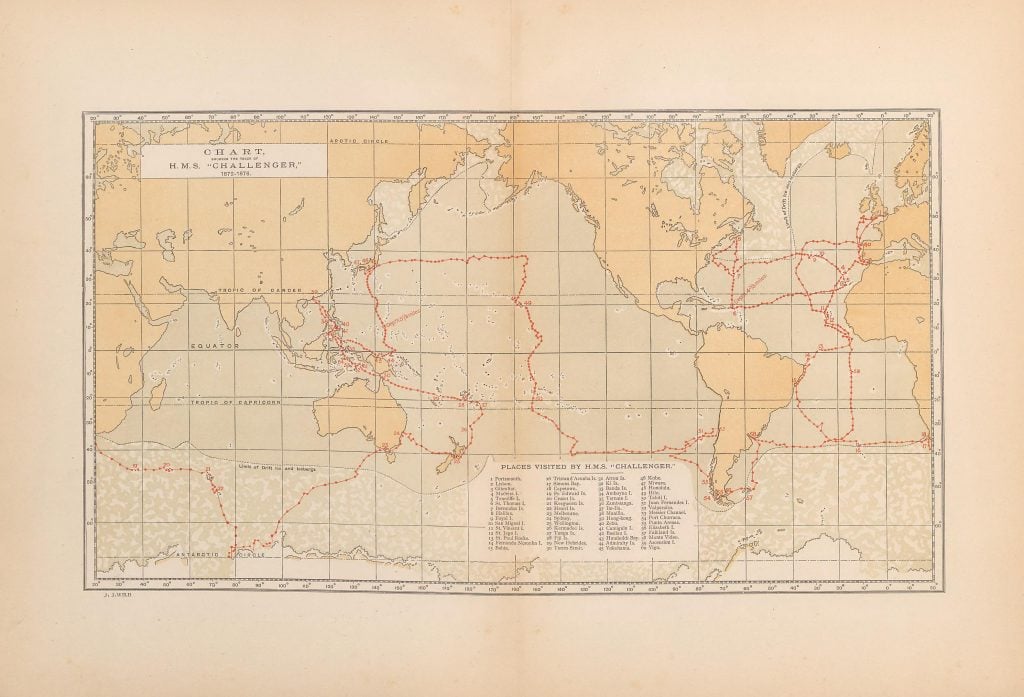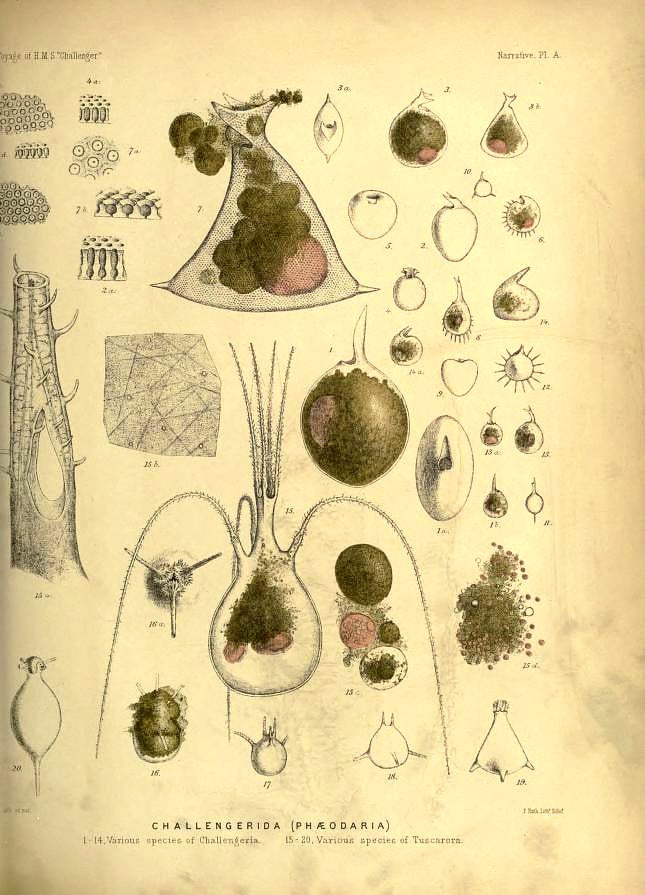In late March 1874 two cricket matches took place in Melbourne. Nothing unusual there. The teams didn’t display particularly outstanding skills. The games received only passing reference in the newspapers of the day. Why were they interesting? Well they could lay claim to being the brainiest cricket encounter in Melbourne and possibly the world.
The two combatants were a University team and a team made up of crew and scientists from the scientific expedition ship HMS Challenger. The peregrinations of HMS Challenger, exploring the depths of the world’s oceans, was amongst the greatest scientific endeavors of the 19th century and resulted in a massive published series of scientific results.
 HMS Challenger amongst icebergs in the Antarctic, next stop Melbourne. Illustration from At anchor : A narrative of experiences afloat and ashore during the voyage of H.M.S. “Challenger” from 1872 to 1876
HMS Challenger amongst icebergs in the Antarctic, next stop Melbourne. Illustration from At anchor : A narrative of experiences afloat and ashore during the voyage of H.M.S. “Challenger” from 1872 to 1876
The journey to that cricket field in Melbourne’s early autumn, and beyond, was a long and eventful one.
In the 1840s, Edward Forbes, a Scottish naturalist, posited his azoic theory that that no life existed in the deep sea (beyond 300 fathoms).
While this was initially accepted, Forbes’ theory came under increasing scrutiny as fledgling studies of the ocean’s depths developed. In 1866 another Scottish naturalist, C. (Charles) Wyville Thomson prevailed upon his friend, Dr William Carpenter, at the time a vice president of the Royal Society, to lobby the British Admiralty for use of a Royal Navy ship to conduct dredging.
 Chemical laboratory. Illustration from Report on the scientific results of the voyage of H.M.S. Challenger 1
Chemical laboratory. Illustration from Report on the scientific results of the voyage of H.M.S. Challenger 1
Clearly the Admiralty were in a mood to support the scientific investigations of Carpenter and Thomson, providing, in several successive years, the use of Royal Navy ships with indulgent commanders and acquiescent crews.
Thomson and Carpenter were ready for a far more adventurous and ambitious use of the Royal Navy’s resources. Again, with the backing of the Royal Society, Thomson and his allies convinced the Admiralty and the government to provide support for a scientific exploration of the world’s oceans, in the form of a ship, commander, crew and funds.
 Zoological laboratory on the main deck. Illustration from Report on the scientific results of the voyage of H.M.S. Challenger 2
Zoological laboratory on the main deck. Illustration from Report on the scientific results of the voyage of H.M.S. Challenger 2
London’s Times newspaper remarked, in reference to the previous limited expeditions and preparations for the major expedition:
the great scientific and practical importance of the facts revealed by these short and imperfect inquiries was such as to render their continuance a matter of national concern….[Mr Lowe (Treasury)] fully recognizes that matters which it is fitting for the country to undertake should be carried through with every advantage that money can secure… [and Mr. Goschen (Admiralty)] lent himself heartily to the scheme.3
 Dredging and sounding arrangements on board the Challenger. Illustration from Report on the scientific results of the voyage of H.M.S. Challenger 4
Dredging and sounding arrangements on board the Challenger. Illustration from Report on the scientific results of the voyage of H.M.S. Challenger 4
HMS Challenger was powered by both steam and sail, and captained by experienced Royal Navy man George Nares, (a veteran of the Franklin searches 5.) It was a ship built for battle, and had previously visited Australia in that capacity, but now, it was adjusted for a new peaceful purpose. Many of the guns were removed to make space for the scientists, along with their laboratories and equipment.
The expedition sailed from Portsmouth on 21 December 1872 with six scientists aboard, together with 20 officers and 200 crew. They traversed the oceans, methodically and laboriously dredging to uncover the mysteries of its great depths.
 Map from At anchor : A narrative of experiences afloat and ashore during the voyage of H.M.S. “Challenger” from 1872 to 1876 , p.196 (Click on image to enlarge)
Map from At anchor : A narrative of experiences afloat and ashore during the voyage of H.M.S. “Challenger” from 1872 to 1876 , p.196 (Click on image to enlarge)
Challenger arrived in Hobson’s Bay on 17 March 1874. Ship’s artist and secretary John James Wild described Melbourne as ‘the precocious child of the 19th century.’ His first impressions though were equivocal:
The first view of Melbourne and of its port, as seen from the anchorage, was not prepossessing…… The eye first encounters a long wooden pier crowded with shipping, beyond, an agglomeration of sheds, timber houses, and tall chimneys; and some miles inland, a ridge crowned with buildings, towers, and steeples which mark the site of the famous capital of Victoria. No wooded islets dipping into the sea, no rocky promontories festooned with flowers, no stately mountains here welcome the traveller weary of the monotonous look-out from the deck of his ship. Yet these deficiencies, if such they be—and perhaps our young Australian friends may differ from us—are forgotten as soon as he finds himself in the palatial streets of Melbourne.6
But what about the cricket matches?
The first game took place on Thursday 26 March, 1874. Disappointingly, many of the prospective players found the delights of the booming city of Melbourne to be more interesting than a game of cricket and the Challenger team arrived with only 6 players. Buoyed by additional players from their hosts, they nonetheless managed to achieve a victory and afterwards, enjoyed a luncheon as guests of the University’s professors. In the return match on Monday 30 March the University were comfortable winners.
John Murray, the dominant personality of the scientific staff, batted down the order and did not trouble the scorers. He became the most well-known of the Challenger scientific staff. Following the death of Wyville Thomson in 1882 Murray supervised the massive publication programme.
 Creatures of the deep. Illustration from Report on the scientific results of the voyage of H.M.S. Challenger during the years 1873-7 7
Creatures of the deep. Illustration from Report on the scientific results of the voyage of H.M.S. Challenger during the years 1873-7 7
The final result of the Challenger expedition, after three and a half years voyaging, were 50 volumes of reports, the last publication arriving 19 years after the completion of the voyage.
It was a scientific watershed, establishing firmly the sciences of oceanography and marine biology and greatly increasing the world’s knowledge of the sea.
The scientists with the expedition were led by Wyville Thomson. Young German zoologist Rudolf von Willemos-Suhm died during the voyage. The other scientists went on to have distinguished careers.
Our Library holds all volumes of the Report on the scientific results of the voyage of H.M.S. Challenger. The NASA Challenger Space Shuttle programme was named for the HMS Challenger expedition.
Further reading
The depths of the sea by C. Wyville Thomson. London: Macmillan, 1873
Scientists and the sea, 1650-1900 : a study of marine science by Margaret Deacon. London ; New York: Academic Press, 1971
The silent landscape : the scientific voyage of HMS Challenger by Richard Corfield. Washington, D.C.: Joseph Henry Press, 2003
Footnotes
- Vol. 1, pt. 1 p.12
- Vol .1, pt 1, p. 6
- Times (London) 5 December 1872 p.3
- Vol. 1, pt 1, p. 57
- In 1845 John Franklin, with the ships Erebus and Terror, led an expedition to the Arctic Ocean attempting to find a North-West passage between the Atlantic and the Pacific. The expedition disappeared and extensive searches continued for many years finding only scant evidence of the fate of the expedition. All members perished. Finally the wreck of Erebus was located in 2014, and Terror in 2016
- At anchor : A narrative of experiences afloat and ashore during the voyage of H.M.S. “Challenger” from 1872 to 1876 by John James Wild ; with illustrations by the author. London: Marcus Ward. John James Wild p78
- Vol. 1, pt. 1, p. 12

